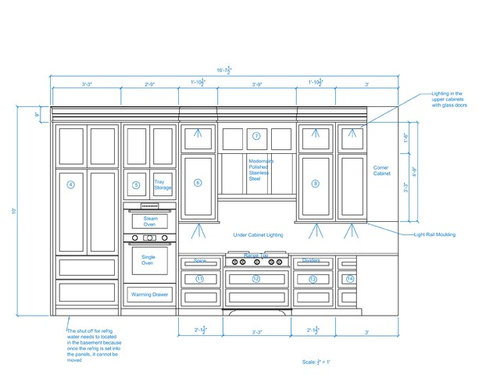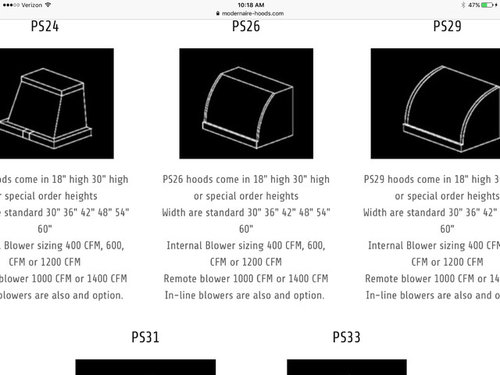Modernaire PS-26 hood help
My kitchen designer has never used a modernaire hood and is working with a source that I'm not totally confident in? It is the PS-26 that is popular here and I have always loved.
My stacked cabinets are inset and the uppers are 13" deep vs. 12" deep. KD thinks we may need to make the top of the hood custom at 13" instead of standard at 12" to accommodate the 13" deep uppers. I will if it is needed, but I just want to make sure.
If a customer has 13" deep uppers, does that require the custom hood in this style be made at 13" depth vs the standard 12"?
How do other customers handle this dilemma?
Here is my wall.
please check this for me if you know. Thank you.

Here is the hood

Comments (15)
ILoveRed
Original Author6 years agoI just realized I posted an older version of this wall that specs the hood (which we had originally planned as wood) at 45" wide over 36" rangetop.
It is changed to 42" wide. Sorry for the confusion.
Trevor Lawson (Eurostoves Inc)
6 years agoAs retailer and distributor for ModernAire hoods on the east coast. Functionally it makes no difference at all. Visual wise 13" depth would be better. I would say that 90% of customers who have a 13" + top cabinet depth go with the extra depth. having said that to answer your actual question "its not needed".
ILoveRed
Original Author6 years agoHi Trevor. Thank you for responding.
We are considering customization of the top of the hood.
This may seem like a silly question.
if we increase the top of the hood from 12" to 13 " depth to accommodate the 13" deep cabinets (without changing the depth of the rest of the hood), does that slight change in radius change the appearance of the hood?
ILoveRed
Original Author6 years agoAlso Trevor is 1200 CFM correct for a 36" Wolf rangetop? Again, thank you.
Trevor Lawson (Eurostoves Inc)
6 years agoIf you go from 12" depth to 13" you wont notice the difference. I would always go with a 1200 cfm Blower.
ILoveRed thanked Trevor Lawson (Eurostoves Inc)ILoveRed
Original Author6 years agoKaseki...thank you for the great explanation. It seems both you and Trevor agree with my kd and hood person that 1200 is correct. We live in the boonies so no one is checking on these things but I would like to get it right.
ILoveRed
Original Author6 years agoTrevor...so 1200 cfm it is.
I hate to beat a dead horse but may I ask two more questions?
-if I'm going to do a custom hood anyway, and I'm adjusting the length of the hood as well.....minimum above rangetop is 30" and maximum is 36" according to the Modernaire website. What height above rangetop do you think is ideal?
-is it a backdraft damper that keeps cold air from blowing back into the kitchen? Is that standard or something I need to make sure I am getting?
thank you for sharing your expertise.
kaseki
6 years agoI suggest that you draw to scale a side view of the range top and hood with a stick figure cook in front of the range. Observe sight lines to the pans at the back. Observe the effect of the (tallest) cook's bending forward on his head intersection with the hood. If the hood is drawn on a separate piece of paper, it can be moved up and down to see the effect of placement.
Mine is at 34.5 inches. While the hood should in principle grow in aperture area as the aperture is placed higher and higher over the range to maintain capture percentage, this is not usually bothered with in the region of 30 to 36 inches, particularly if you have already addressed hood overlap with the pan bases.
Note that commercial hoods typically are at seven feet from the floor, i.e., 4 ft above the cooktop. A typical size is 4 ft front to back and significantly longer than the cooking zone. This deals with the expanding rising plumes, and also with cross drafts, which should no be neglected from consideration in residential applications.
kaseki
6 years agoForgot the damper question: "is it a backdraft damper that keeps cold air from blowing back into the kitchen?" Yes, that is its purpose, and I would recommend one at each end of the duct. Some hoods will include a damper. I don't know how standard it is to do so. Dampers and other duct components may be available from local HVAC distributors, or can be ordered from Fantech.
ILoveRed
Original Author6 years agoThank you Kaseki for sharing all of your knowledge regarding both questions I asked here. DH is 6'2" and I am 5'6". So I am thinking it needs to go up. I will follow your advice and make sure it is at the right height.
i will also make sure that we have a backdraft damper at both ends.
thank you for the source fanteck
if my duct is round and 9 7/8 then I need a 10" like this one? Or two I should say. Thank you.
kaseki
6 years agoYes, that damper is typical. Note that neither side is shown crimped. Either one side has to be crimped (the one to be closest to the hood), or you need a band clamp such as Fantech sells for such purposes as attaching duct to their silencers.
kaseki
6 years agoDuct sections are typically crimped at one end so the section fits into another section. By crimping I do not mean mashing the entire end together, but effectively corrugating the sheet metal with the effect of making its diameter smaller. A typical do-it-yourself crimp tool:
A dual crimped duct union
 ILoveRed thanked kaseki
ILoveRed thanked kasekiILoveRed
Original Author6 years agoThanks Kasecki...found out the hood I'm using has a backdraft damper. Thought I would let you know since you have been so helpful.

kaseki